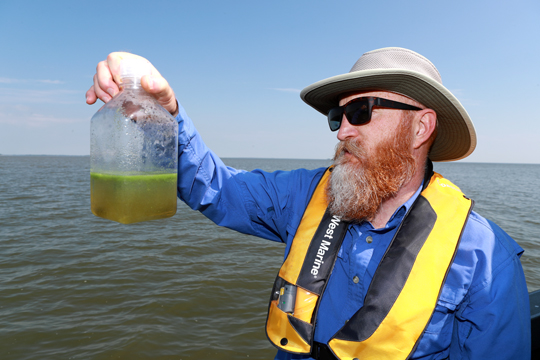During a weekly water sampling expedition in late July aboard The University of Toledo Lake Erie Center’s 28-foot research vessel, UT senior Alex Lytten holds the buoy steady as fellow senior Zach Swan sprays and scrubs it clean of algae and bird droppings.
For the third year in a row, UT’s water quality and sensor buoy floats in Lake Erie’s Maumee Bay providing live data accessible 24/7 to anyone by smart phone.

Dr. Tom Bridgeman, UT algae researcher and professor of ecology, examined a water sample aboard the UT Lake Erie Center research vessel.
“The bloom is on its way,” said Dr. Tom Bridgeman, UT algae researcher and professor of ecology, who has been focused on this problem for nearly two decades. “The blue-green algae is growing very rapidly right now. It’s growing leaps and bounds.”
Nearby at the city of Toledo water intake that pumps raw lake water to the plant, Bridgeman uses a pulley to draw a water sample and concentrates it into a jar.
It holds a mix of bright green and olive green algae. The olive green algae — “the good algae called diatoms,” according to Bridgeman — sinks to the bottom of the bottle. The bright blue-green algae — “the bad algae responsible for producing toxins such as microcystin” — stays at the top.

Eva Kramer, UT graduate student pursuing a master’s degree in ecology, lowered the YSI EXO sonde into the water. The instrument is comprised of several probes to measure various water quality parameters, including the amount of blue-green algae present, oxygen levels, water temperature and pH.
“It’s growing exponentially,” Bridgeman said.
The researchers also spot a spiny water flea, an invasive species from the Caspian Sea, in the water sample. It’s eating the other zooplankton moving in the jar.
Eva Kramer, a UT graduate student researcher who is pursuing a master’s degree in ecology, mans the big blue wand called a YSI EXO sonde, which is comprised of several probes to measure various water quality parameters, including the amount of blue-green algae present, oxygen levels, water temperature and pH. It’s the same instrument mounted inside UT’s buoy.
Kramer first lowers the sonde for a surface reading and then even lower for a deeper reading.
“Here it’s about six meters deep,” Kramer said.Swan submerges the black-and-white Secchi disk to measure how far below surface it disappears from view.
“It’s 160 centimeters,” Swan said.
“That’s higher than I thought,” Kramer said.
Lytten, who also serves as boat captain, uses a long tube that reaches the bottom of the lake to draw a water column sample.
“We’re collecting a plug of water, instead of just on the surface,” Bridgeman said.
The research team takes the samples collected throughout Maumee Bay and the open waters of the western basin back to the Lake Erie Center lab to process and analyze for algal toxins and chemical signals that will provide clues to help predict future blooms.
“We are watching very closely and prepared,” Bridgeman said. “We expect to get a big bloom this year, but it’s not necessarily going to cause a problem. It’s usual, but it’s not acceptable.”
Bridgeman and his team will continue these sampling trips throughout the summer as one part of the University’s efforts to address harmful algal blooms.
In addition to the environmental scientists, UT has experts conducting water quality research in a diverse breadth of areas, including economics, engineering, business, pharmacy, law, chemistry and biochemistry, geography and planning, and medical microbiology and immunology.